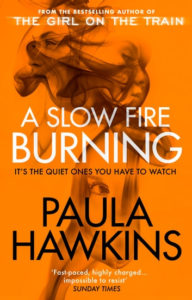The title of the story A Slow Fire Burning makes perfect sense. The expression refers to the decomposition process of books, whose paper yellows and degrades due to the acid they release over time. This phenomenon of wear and tear and self-destruction is a powerful metaphor that reveals the nature of the novel. In this regard, the women who lead the story have suffered severe traumatic experiences and as a consequence harbor serious psychological wounds that slowly and dangerously consume them.

It all begins with a gruesome crime that occurred on a houseboat in London, the victim is Daniel Sutherland, a young man of twenty-three. The police come across a bloody and brutal murder and the evidence leads the investigators to three women with very different profiles.
Heading the list of suspects is the temperamental and unstable Laura Kilbride. A fascinating character: on the one hand, impulsive and ruthless with a tendency to do uninhibited and stupid things. On the other hand, vulnerable and compassionate with a big heart. This is a young woman who has suffered all kinds of setbacks and who barely manages to survive. Laura frequently experiences feelings of emptiness, self-loathing, and worthlessness. She appears with blood on her hands, and witnesses place her with Daniel Sutherland on the day of the murder. Beforehand, Laura is positioned as the prime suspect in the police investigation.
It is noteworthy that when Laura Kilbride was ten years old, she was run over by her mother’s lover. This unfortunate incident caused a brain injury that left her unable to control her impulses for the rest of her life. Laura is left broken physically, mentally and emotionally. From an early age, the young woman has been the victim of terrible circumstances and it seems that bad fortune follows her. Eventually, an unlikely friendship with a kindly old woman helps her come to terms with herself.
Among the other persons of interest Carla Myerson, the aunt of the murdered young man, also stands out. For a long time, this woman had a dream life, high social position, beauty, good taste, an adoring husband, and a beautiful child. Unfortunately, the unexpected death of her son Ben destroys her forever. Carla and her husband never stop blaming themselves. Neither she nor her family can overcome their grief.
Carla Myerson’s adult life has been marked by profound personal losses. She mourns the death of her son, her sister, and now her nephew Daniel. Unable to cope with the tragedy, Carla has condemned herself to lethargy, to emptiness, to her own purgatory. Although Carla is alive, she does not feel alive.
The police investigation also turns to Miriam Lewis, an indiscreet neighbor who eventually discovers Daniel’s corpse. Miriam works in a floating bookstore and remains extremely attentive to the lives of her neighbors. In fact, she is in the habit of making notes about the daily life in London’s Regent’s Canal. She is the one who offers the first clues and statements to the police officers, but she also hides key information about the murder.
Miriam is a middle-aged woman, without much money, without a partner, and without any power. She has always felt like an outsider, a freak on the fringes of society. Like Laura, Miriam suffered a traumatic event during her youth from which she has not been able to recover. Despite the passage of time, that violent incident continues to eat away at her and hurt her. Aggrieved on more than one occasion, Miriam Lewis yearns for revenge and will go to great lengths to take justice into her own hands.
These are three women to whom life has shown its darkest side. All have suffered in some way, all have had to face injustices, losses and tragedies that have broken their spirits. The author explains that despite all they have been through, these women “are not damsels in distress, they are unusual heroines”, imperfect, forged by pain. Although Laura, Carla and Miriam do not know each other, they will soon realize that they have different connections to each other, and different connections to the victim.
These women “are not damsels in distress, they are unusual heroines”
As for the genre, the novel is replete with conjecture and suspicion. All the incriminated women have something to say and much they prefer to hide. The story is told through the points of view of several characters, and the writer deliberately plays and deceives the readers. As in any good contemporary thriller there are connections that at first no one can imagine. The pages follow one another at an accelerated pace due to the fact that the chapters are quite short.
Paula Hawkins uses a bloody crime to explore the subject of emotional wounds and psychological trauma. The author closely examines the after-effects that traumatic experiences can leave and delves especially into how emotional burdens (resentment, grudges, anger, rage, abandonment, rejection) can lead anyone to self-destruction. In a way, Hawkins makes people ask themselves: if someone caused you irreparable harm, what would you be able to do?
The reader can count on the mystery being solved with cunning and ingenuity. Paula Hawkins offers enough narrative twists to keep the intrigue piqued, yet she also offers enough clues to conclude with substance and sagacity. Interestingly, the novelist leaves some room for doubt and ambiguity, in a way, the reader is still imagining the story when the book is closed.
Paula Hawkins worked as a journalist for more than fifteen years before becoming a fiction author. Her name went around the world when she published the book The Girl on the Train, a psychological thriller that later became a famous film adaptation.
Image: NappyStock

